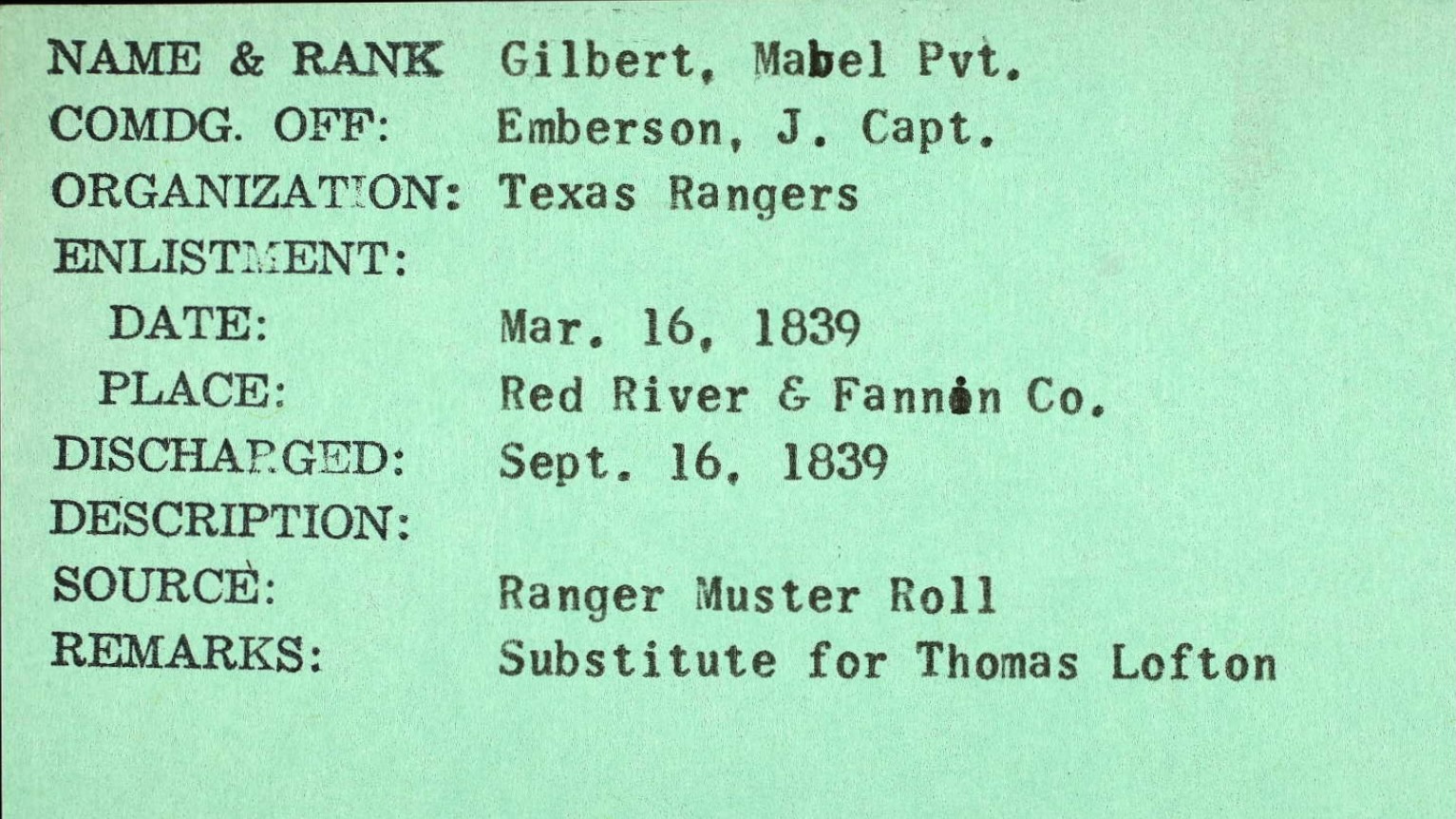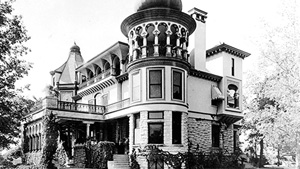
Mabel Gilbert and family only lived in Dallas a few years, but they were contemporaries of the Beemans, John Neely Bryan and other early settlers. The Gilbert family story in Dallas County begins in the 1840s. Mabel Gilbert was born on March 4, 1797 in what is now Dickson County, Tennessee. At that time, however, it was still part of North Carolina. According to genealogy records, his parents were William Gilbert/Gilbreath (1764 – 1827/1836) and Nancy “Nicy” Morris Gilbert/Gilbreath (1770 – 1840). Mabel is believed to have been the third son of the couple. The origin of his first name is unknown as Mabel is generally considered to be a feminine name. Mabel was followed by Temperance Gilbert, a daughter, and at least three more sons. The Gilbert childrens’ years of birth range from 1790 to 1810.
Mabel married Charity “Cherry” Morris (1801 – 1854) in 1821 and over the next thirty-three years, they had at least about eleven children. Their oldest child was Eunice Ann “Nicy” Gilbert, born in 1822. An account of the family’s early life was given in a newspaper interview in the Galveston Daily News issue of November 19, 1893 by Eunice Gilbert Hampton when she was seventy-one years old.
Eunice recalled that their move to Texas in 1837 coincided with the so-called Panic of 1837. This event has been described as a global financial crisis that particularly affected all of the United States. It was characterized by a drastic decline in wages, prices and profits. Depositors lost confidence in banks and withdrew funds. Unemployment increased, credit became unavailable and overall pessimism was common. It sparked a major depression in America that lasted until the 1840s.
The Gilbert family settled about October 1, 1837 on a claim about three miles south of what is now Bonham, Texas and about that same distance from Fort Inglish. Fort Inglish was not a United States Army fort but rather had been established by area residents to defend themselves against attacks by native tribes. Mabel was on the rolls of the Texas Rangers but participated in defense of family and other settlers many times. Eunice recalled an attack against the settlers in which a number of lives were lost. Mabel joined in the pursuit of the raiders. While he was away there was another incident with a second group of Indians. Cherry Gilbert sent the children to Fort Inglish while she retreated to a blockhouse that Mabel had built. The tribesmen approached and some spoke enough English that they were able to communicate. The tribesmen explained that they meant no harm, but requested permission to camp in a field nearby. Militiamen from the fort came expecting a fight and were ready to attack the Indians when Mrs. Gilbert explained the situation. The troops retreated and the Indians eventually left for their main camp elsewhere. Eunice married in 1840 and described other encounters with the tribes. The rest of the interview is devoted to Eunice’s later life.
Mabel was called “Captain Gilbert” presumably as a reference to his prior work on Mississippi River steamboats, although his time as a steamboat captain is not yet documented. His older brother, Captain Thomas G. Gilbert, owned and operated a steamship line. His service in that business is said to be documented in a 1961 book called “Steamboatin’ On The Cumberland” by Judge Byrd Davis in quotations that are attributed to this book.
By 1840, Gilbert had established a farm of 1,280 acres and first constructed a horse powered grist mill, replacing it some time later with an oxen powered mill. Around that time, Gilbert moved his family first to what was to become Tarrant County and was one of the individuals who helped to build and establish the blockhouse fort known as Bird’s Fort, named for General Jonathan Bird. He took part in some of the fighting between the native tribes and militia, and moved his family there briefly. Perhaps due to some land title issue with Peters Colony, Gilbert and his family did not remain there long before moving a little more than twenty miles further down the Trinity River to a new settlement that John Neely Bryan was trying to establish. The Gilberts are believed to have built a cabin near the current location of downtown Dallas but only resided there for about two years before returning to their Fannin County property.
Mabel Gilbert had an older brother named Wilson Gilbert (1795 – 1873). Less is known about this individual when compared to Mabel Gilbert. However one of the legends of the naming of the City of Dallas involves Wilson Gilbert. The clipping below from the Galveston Daily News in its issue of July 28, 1876 is connected to the naming having been for Pennsylvania statesman George Mifflin Dallas (1792 – 1864). Dallas was a United States Senator from Pennsylvania and later served as Vice President of the United States under President James K. Polk.
The above is one of several legends about the town’s name. No one really knows the origin of the name of the city of Dallas, since John Neely Bryan did not document his reason for selecting the name in any source that has survived. Some may associate the above legend with Mabel Gilbert, but Wilson Gilbert was married first to Nancy Kennedy and second to a woman whose name was Martha (last name unknown). It is not known how long Wilson Gilbert lived in Dallas County. He apparently moved from Dallas back to Bonham, as did his brother Mabel Gilbert, and resided there until his death.
Mabel Gilbert and his family departed from Dallas as well, probably around 1845, returning to Bonham. There he resumed farming and also was engaged in the lumber business, having built a steam powered sawmill. The family had lived there for a bit less than ten years when his wife Cherry died in 1854. About a year later, he married Rachel Gibbs Albright Freeman, a widow in the area. Mrs. Freeman had one child. Around 1856, Gilbert moved again, this time settling very near the Red River in what is now Wichita County. He built a home there but troubles with the native tribes caused him to relocate once more to Montague County between the current towns of Montague and Saint Jo for a short time. Gilbert returned to Wichita County about 1859 where he is believed to have lived until he died, except for one more period in which he returned to Montague County. He died in 1870 in Gainesville while on a trip to buy supplies, Mabel is believed to be buried on his property in Wichita County.
Mabel Gilbert and his family are considered to be the first Anglo settlers of Wichita County. The where the town of Burkburnett now lies was originally called Gilbert. Several creeks are named for Mabel Gilbert, one in Fannin County, another long and meandering creek in Wichita County that flows into the Red River and a third in Dallas County, now known as Kidd Springs. Mabel and Cherry Gilbert had eleven children to are believed to have survived to adulthood. Mabel and Rachel Gilbert had another ten children, so there are many descendants of Mabel Gilbert and his spouses Cherry and Rachel. After Mabel’s death, Rachel and her children left Wichita County and moved near Gainesville. She survived Mabel another twenty-four years before she passed away. She is interred in Cooke County, Texas.
Get future posts by email.



